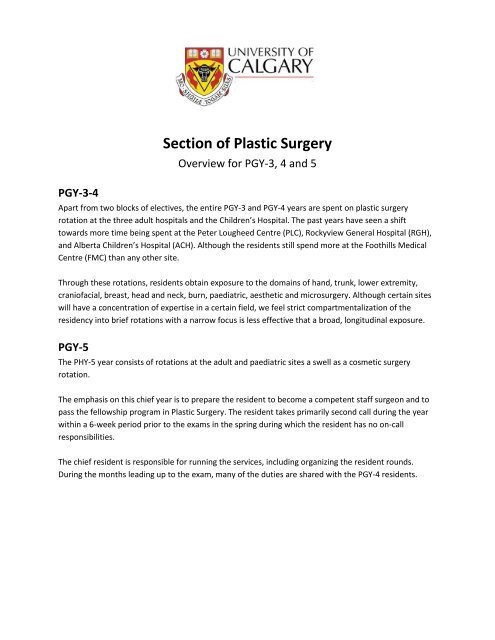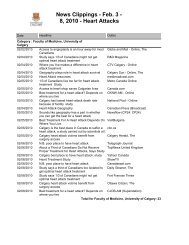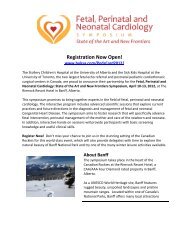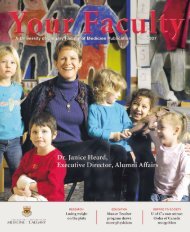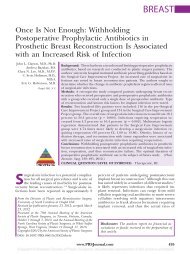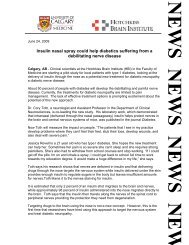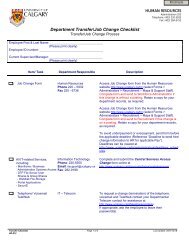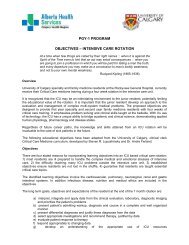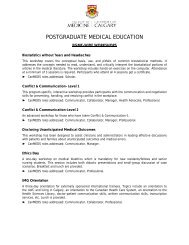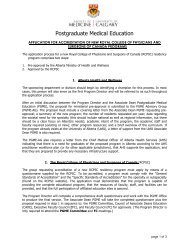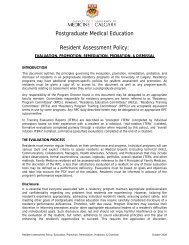Overview of Rotation Educational Objectives
Overview of Rotation Educational Objectives
Overview of Rotation Educational Objectives
Create successful ePaper yourself
Turn your PDF publications into a flip-book with our unique Google optimized e-Paper software.
PGY-3-4Section <strong>of</strong> Plastic Surgery<strong>Overview</strong> for PGY-3, 4 and 5Apart from two blocks <strong>of</strong> electives, the entire PGY-3 and PGY-4 years are spent on plastic surgeryrotation at the three adult hospitals and the Children’s Hospital. The past years have seen a shifttowards more time being spent at the Peter Lougheed Centre (PLC), Rockyview General Hospital (RGH),and Alberta Children’s Hospital (ACH). Although the residents still spend more at the Foothills MedicalCentre (FMC) than any other site.Through these rotations, residents obtain exposure to the domains <strong>of</strong> hand, trunk, lower extremity,crani<strong>of</strong>acial, breast, head and neck, burn, paediatric, aesthetic and microsurgery. Although certain siteswill have a concentration <strong>of</strong> expertise in a certain field, we feel strict compartmentalization <strong>of</strong> theresidency into brief rotations with a narrow focus is less effective that a broad, longitudinal exposure.PGY-5The PHY-5 year consists <strong>of</strong> rotations at the adult and paediatric sites a swell as a cosmetic surgeryrotation.The emphasis on this chief year is to prepare the resident to become a competent staff surgeon and topass the fellowship program in Plastic Surgery. The resident takes primarily second call during the yearwithin a 6-week period prior to the exams in the spring during which the resident has no on-callresponsibilities.The chief resident is responsible for running the services, including organizing the resident rounds.During the months leading up to the exam, many <strong>of</strong> the duties are shared with the PGY-4 residents.
<strong>Rotation</strong> Specific <strong>Objectives</strong>Plastic Surgery ResidentsPGY-3, 4 and 5The residents PGY 3 – 5 years consist <strong>of</strong> rotations at the three adult hospitals (FMC, PLC,and RGH), the ACH, private surgical centres, and elective time.At these sites, the residents gain exposure to the broad spectrum <strong>of</strong> plastic surgerydisciplines, including hand surgery, burn surgery, breast surgery, crani<strong>of</strong>acial surgery,microsurgery, head and neck reconstruction, cosmetic surgery, and pediatric surgery.Our program is one <strong>of</strong> a small number <strong>of</strong> Canadian Residency Training Program allowsthis breadth <strong>of</strong> exposure.Because the residents will see a variety <strong>of</strong> subspecialty surgery at each rotation,assigning rotation specific objectives is somewhat arbitrary; For example, residents willsee hand surgery and breast surgery at each adult site they rotate through as these arestaples <strong>of</strong> almost every plastic surgeon’s practice.Although this makes designating rotation specific objectives more difficult, we feel thisbroad exposure over several years is the best way to become expert in the diversespecialty <strong>of</strong> plastic surgery.With this in mind, the following objectives are not “all-inclusive”, but rather reflectpractices with the tendency for certain subspecialties to be more prevalent at each site.1
Foothills Medical Centre (FMC)The residents spend more time at the Foothills Medical Centre than any other site. Theyhave rotations in their R1, R3, R4, R5 years.The majority <strong>of</strong> the resident’s exposure to multi-trauma, burn surgery, crani<strong>of</strong>acialsurgery, head and neck reconstruction, and microsurgery is obtained at the FoothillsMedical Centre.Rockyview General Hospital (RGH)The Rockyview General Hospital <strong>of</strong>fers an exposure to more <strong>of</strong> a community-type plasticsurgical practice. Although complex, multidisciplinary procedures are not uncommon,the emphasis is on elective surgery <strong>of</strong> the hand and breast and body contouring, andaesthetic facial surgery.Peter Lougheed Centre (PLC)The Peter Lougheed Centre has increasingly become the focal point for reconstruction<strong>of</strong> the upper and lower extremity. In addition, surgery <strong>of</strong> the breast, body contouring,and aesthetic surgery are represented.Alberta Children’s Hospital (ACH)The Alberta Children’s Hospital isPrivate ClinicsA concentrated exposure to aesthetic surgery is obtained during the resident’s finalyear.2
<strong>Rotation</strong> <strong>Educational</strong> <strong>Objectives</strong>Foothills Medical Centre - Burn UnitMEDICAL EXPERTKnowledgeThe physician shall attain a working knowledge <strong>of</strong> …..PGY- 3-41. Pathophysiology <strong>of</strong> the burn wound2. Mechanism <strong>of</strong> development <strong>of</strong> burn shock3. Understanding <strong>of</strong> resuscitation <strong>of</strong> burn shock4. Understanding <strong>of</strong> complications <strong>of</strong> fluid resuscitation including limb andabdominal compartment syndrome, pulmonary edema, and airway compromise.5. Indications for airway protection/prophylactic intubation <strong>of</strong> a burn patient, andthe pathophysiology and clinical management <strong>of</strong> smoke inhalation injury, COpoisoning, and HCN poisoning.6. Understanding <strong>of</strong> indications escharotomy for both trunk and the limbs.7. Understanding <strong>of</strong> indications for and approach to surgical decision makingsurrounding early excision and closure <strong>of</strong> the burn wound, for both minor andmajor injuries.8. Understanding <strong>of</strong> the role <strong>of</strong> nutritional support and metabolic alterations in theburn patient.9. Understanding <strong>of</strong> the role and use <strong>of</strong> topical antimicrobials and dressings forburn wounds.10. Understanding <strong>of</strong> complications and management <strong>of</strong> complications associatedwith significant burn injury, specifically sepsis and ARDS.11. Understanding <strong>of</strong> ventilation modalities for burn patients including protectiveconventional ventilation, high-frequency percussive ventilation, and highfrequencyoscillatory ventilation.12. Understanding <strong>of</strong> the indications for and use <strong>of</strong> skin substitutes.13. Understanding <strong>of</strong> approach to chemical and electrical burns, and specificconsiderations in these specialized burn injuries.14. Understanding <strong>of</strong> burn centre approach to management <strong>of</strong> severe exfoliativedisorders such as Toxic Epidermal Necrolysis.15. Understanding <strong>of</strong> the pathophysiology <strong>of</strong> scar and hypertrophic scar formation,and the modalities used in conjunction with the burn Rehabilitation Therapist tocontrol hypertrophic scar formation.16. Understanding <strong>of</strong> the rationale behind splinting in the burn patient, andknowledge <strong>of</strong> correct positioning and splinting for the burn patient in the acute,perioperative and late (rehabilitation) phases.17. Understanding <strong>of</strong> approach to analgesia in burn patients including opioid andnonopiod modalities.3
PGY-51. Understanding <strong>of</strong> the management <strong>of</strong> burns to the hand, including nonoperativemeasures (elevation, splinting, wound care, mobilization, analgesia),operative indications and techniques, and post-operative care.2. Understand management <strong>of</strong> burns to the face, ears and neck, including nonoperativemeasures, surgical approach/decision making surrounding excisionand closure, use <strong>of</strong> aesthetic units concept, post operative care.Clinical SkillsThe physician shall show competency with respect to…..PGY- 3-41. Performance <strong>of</strong> a thorough history from a burn patient including mechanism <strong>of</strong>injury, factors relevant to the airway and possibility <strong>of</strong> smoke inhalation injury,timing <strong>of</strong> injury, specialized considerations in chemical and electrical burns,considerations to pre-injury medical and socio-economic status and theirrelevance to the burn injury.2. Completion <strong>of</strong> thorough medical records and progress notes pertaining to 1, andcompletion <strong>of</strong> a burn diagram or Lund/Browder diagram.3. Completion <strong>of</strong> a thorough physical exam to include examination <strong>of</strong> the burnwound, diagnosing burn depth, examination <strong>of</strong> the airway, and the burnedextremities.4. Ability to approach all burn patients using the Advanced Burn Life Support (ABLS)approach to include a primary and secondary survey.5. Ability to complete admission orders for both minor and major burn injuries.6. Ability to function within the close working relationship <strong>of</strong> the burn team andwork effectively with nurses, PT, OT, social worker, nutritionist, pharmacist.PGY-51. Ability to council the patient and/or next <strong>of</strong> kin regarding the extent <strong>of</strong> apatient’s injury, probability <strong>of</strong> survival, potential complications, prognosis, andtreatment plan, in a pr<strong>of</strong>essional and compassionate manner.Technical SkillsPGY- 3-41. Central venous and arterial line insertion in the burned patient.2. Escharotomy <strong>of</strong> the limbs, hands, thorax/abdomen.3. Naso and/or oro-gastric decompression and feeding tube insertion in the burnedpatient.4. Measurement <strong>of</strong> intra-abdominal pressure by bladder pressure measurement inthe burned patient.5. Use <strong>of</strong> blood conservation techniques for burn excision and graft harvestincluding epinephrine tumescence and use <strong>of</strong> tourniquets.6. Harvest <strong>of</strong> skin grafts with the power dermatome.7. Meshing <strong>of</strong> skin grafts.4
8. Application and fixation <strong>of</strong> both meshed and sheet autografts and allograft.PGY-51. Techniques and ability to position the burn patient in the operating roomincluding prone positioning, limb elevation, use <strong>of</strong> Steinman pins for limbelevation.2. Application <strong>of</strong> secure dressings and construction <strong>of</strong> the quilted dressing.3. Preparation, application, fixation and dressing <strong>of</strong> Integra artificial skin substitute.4. Excision and grafting <strong>of</strong> specialized areas specifically the hand, face, and eyelids.5. Basic release <strong>of</strong> burn contractures including transverse release, Z plasty, 4-flap Zplasty.6. Release/correction <strong>of</strong> burned eyelid ectropion.7. Tangential excision <strong>of</strong> the burn wound and ability to accurately determineadequacy <strong>of</strong> excision and viability <strong>of</strong> wound bed.8. Technique <strong>of</strong> fascial excision.COMMUNICATORPGY- 3-41. Develop rapport, trust and ethical relationships with burn patients andtheir families2. Accurately elicit and synthesize relevant information and perspectives <strong>of</strong>patient’s families, colleagues and other pr<strong>of</strong>essionals3. Accurately convey relevant information and explanations to patients andfamily, colleagues and other pr<strong>of</strong>essionals4. Develop a common understanding on issues, problems and plans withpatients and families, colleagues and other pr<strong>of</strong>essionals to developed ashared plan <strong>of</strong> care5. Convey effective oral and written information about a medical encounter6. Obtain and synthesizes relevant history from patients and family7. Write a preliminary report on operations on chart8. Write clear progress notes, clinic notes and discharge summaries9. Is able to inform patients and families about their condition at anappropriate and understandable level, and in particular discuss complexissues surrounding the progress or deterioration <strong>of</strong> a critically ill burnpatient.10. Dictates concise and clear description <strong>of</strong> operation11. Writes clear and consultation notes and discharge summaries and clinicnotes12. Prepares and presents rounds in an organized manner, including AM unitrounds (Hand clinic, Burn clinic, Burn rounds) and weekly multidisciplinaryburn team rounds13. Participates actively in scheduled rounds5
PGY-51. Develop ability to discuss critical and life threatening illness and treatment andend-<strong>of</strong> life decisions with burn patient’s families2. Able to explain surgical interventions, options and expected morbidity andprognosis to patients and familiesCOLLABORATORPGY-3-41. Participate effectively and appropriately in an inter-pr<strong>of</strong>essional healthcare team, especially the tight inter-workings <strong>of</strong> the burn care team andeffectively work with other health pr<strong>of</strong>essionals to prevent, negotiate andresolve interpersonal conflict2. Works with ward, burn unit and operating room nurses to managepatients3. Appropriately identifies social, rehabilitative, dietetic concerns withpatients and consults appropriate allied health pr<strong>of</strong>essionals4. Consults and works with medical specialists appropriatelyPGY-51. Assists allied health pr<strong>of</strong>essionals through active participation theirtraining and educational roundsMANAGERPGY-3-41. Participate in activities that contribute to the effectiveness <strong>of</strong> theirhealthcare organizations and systems2. Manage their practice and career effectively3. Allocate finite healthcare resources appropriately4. Serve in administration and leadership roles as appropriate5. To level <strong>of</strong> training understand the importance <strong>of</strong> and mechanisms <strong>of</strong>safely utilize resources in a cost effective manner to benefit all patients6. Utilizes information technology to optimize learning7. Becomes practical and logical in the approach to clinical problem solvingPGY-51. Recommends practices to effectively utilize resources including theundertaking <strong>of</strong> standard <strong>of</strong> care proceduresHEALTH ADVOCATEPGY-3-46
PGY-51. Respond to individual patient health needs and issues as part <strong>of</strong> patientcare2. Respond to the health needs <strong>of</strong> the communities that they serve Identifythe determinants <strong>of</strong> health <strong>of</strong> the populations that they serve3. Promote the health <strong>of</strong> individuals4. Promote the health <strong>of</strong> individual patients, communities and populations5. Become familiar with the important determinants <strong>of</strong> health affectingplastic surgery patients such as smoking, obesity and other lifestyle andpreventative measures6. Understands the data supporting prevention <strong>of</strong> common burn injuriesespecially hot water scalds and grease fires7. Understands the value <strong>of</strong> outcomes research for surgical procedures8. Treats the individual as a whole person acknowledging, cultural, social,economic, family and personal influences on their psychosocial make-upand on their health and illness9. Assesses all patients for risk factors for a variety <strong>of</strong> plastic surgicalconditions and advises appropriate interventions10. Utilizes preventative measures correctly1. Understands the triage system <strong>of</strong> the surgical waitlist, it’s rationale,how patients are upgraded2. Participates in outcomes <strong>of</strong> research and assists in disseminatingresulting information3. Develops and supports constructive relationships with hospitaladministrators, regional, provincial and federal government agenciesand representatives4. Supports activity <strong>of</strong> local and national organizations promoting healthadvocacySCHOLARPGY-3-47
1. Maintain and enhance pr<strong>of</strong>essional activities through ongoing learning2. Critically evaluate information and its sources and apply this appropriatelyto practice decisions3. Facilitate the learning <strong>of</strong> patients, families, students, residents, otherhealth pr<strong>of</strong>essionals, the public, and others as appropriate4. Contribute to the creation, dissemination, application and translation <strong>of</strong>new medical knowledge and practices5. Recognizes gaps in knowledge and develops strategies to correct this byself directed reading and consulting with other pr<strong>of</strong>essionals6. Contributes knowledge learned to service rounds7. Understands principles and practice <strong>of</strong> basic and applied research includingthe scientific method, design and conduct <strong>of</strong> clinical trials and criticalappraisal <strong>of</strong> literature and the use <strong>of</strong> statistics8. Reads around clinical cases9. Prepares and presents scheduled rounds10. Participates actively in scheduled morbidity and mortality and QualityAssurance conferences11. Actively participates in journal club12. Prepares and present clinical research papers at peer reviewedmeetings/publishes in medical literaturePGY-51. Participates effectively in teaching fellow pr<strong>of</strong>essionals including juniorhouse staffPROFESSIONALPGY3-51. Demonstrates a commitment to their patients, pr<strong>of</strong>ession and society throughethical practice2. Demonstrates a commitment to their patients, pr<strong>of</strong>ession and society throughparticipation in pr<strong>of</strong>ession-led regulation3. Demonstrates a commitment to physician health and sustainable practice4. Delivers care with integrity honesty and compassion5. Understands the pr<strong>of</strong>essional, legal and ethical codes to which physicians arebound6. Exhibits appropriate personal and inter-personal pr<strong>of</strong>essional behaviors and at alltimes functions pr<strong>of</strong>essionally7. Is sensitive to and responds appropriately to different patients <strong>of</strong> different socialstatus, ethnic groups, age and gender8
<strong>Rotation</strong> <strong>Educational</strong> <strong>Objectives</strong>Alberta Children’s HospitalThe Plastic Surgery rotation at the Alberta Children’s Hospital is undertaken in the PGY-1, 3, 4 & 5 years. It is expected that the Plastic Surgery resident will be able tosuccessfully complete the Can Med Goals and <strong>Objectives</strong> as listed below regardless <strong>of</strong>PGY status. The design <strong>of</strong> the rotation is to give the resident in plastic surgery in-depthexposure to all areas <strong>of</strong> pediatric plastic surgery but it is recognized that the residentmay not be exposed to all elements <strong>of</strong> these objectives. However at the conclusion <strong>of</strong>the rotation, the resident should demonstrate knowledge or competency in thefollowing:MEDICAL EXPERTGeneral Pediatric Plastic SurgeryPGY-1, 3 and 41. To acquire knowledge relating to the unique physiology and metabolism <strong>of</strong> thepediatric patient2. To become knowledgeable <strong>of</strong> skin lesions and conditions arising in the pediatricpopulation3. To understand the difference between malformations, deformations anddisruptions4. Knowledge <strong>of</strong> importance differences in mechanisms <strong>of</strong> trauma and woundhealing between children and adults.5. To be able to monitor appropriately the pediatric plastic surgery patientincluding appropriate choice <strong>of</strong> fluid and electrolyte replacement, drug and drugdosing, and blood product management and to be able to recommendappropriate analgesic medication.6. To be able to recognize s<strong>of</strong>t tissue infections and initiate appropriate therapies.7. To be able to manage post-operative complications involving airway, bleeding,fever, dressings, etc.8. To be able to recognize and use appropriate adjunct services such as PT, OT,Social Work, Dietician etc.9. To gain knowledge and apply the use <strong>of</strong> regional anesthetic blocks and sedationin the pediatric population to effectively manage minor trauma in the ER10. To gain knowledge and expertise in the application <strong>of</strong> dressings in the pediatricpatient11. To be able to recommend an appropriate surgical approach and be familiar withnon-surgical alternatives12. To be aware <strong>of</strong> unique timing issues <strong>of</strong> surgical intervention in the pediatricplastic surgery patient9
PGY- 51. To acquire knowledge <strong>of</strong> the various congenital malformations, deformations,disruptions (syndromic and non-syndromic) affecting the face, hands, feet, trunkand genitalia2. To develop the special skills required to be able to communicate with pediatricpatients, parents and family3. To be knowledgeable and participate in standard microsurgical proceduresinvolving facial reanimation, free functioning muscle transfer, brachial plexusreconstruction, flap elevation and transfer.Pediatric Upper ExtremityA) GeneralPGY-1,3-51. Describe and illustrate the normal anatomy and its variations <strong>of</strong> the hand as itrelates to: vascular supply, nerve supply, flexor tendons, extensor tendons,bones, joints, skin, fascia and nails.2. Perform a thorough hand history investigating aspects <strong>of</strong> function, pain and bodyimage3. Perform a complete hand examination.B) FracturesPGY-1, 3 and 41. Understand unique aspects <strong>of</strong> pediatric hand fractures including the Salter-Harrisclassification system2. Demonstrate competence in local anesthesia and sedative techniques toperform closed reduction procedures3. Perform a closed reduction for a hand fracture4. List the complications and risks associated with hand fracturesPGY -51. Describe an algorithm for the management <strong>of</strong> pediatric hand fractures2. Perform an open reduction for a hand fracture3. Describe a corrective osteotomy for a mal-unionC) Extensor TendonsPGY-1, 3 and 41. Classify and describe the treatment for extensor tendon laceration2. Perform an extensor tendon repairPGY -51. Describe the abnormalities and their treatment associated with extensormechanism imbalance both for the digits and the thumb10
D) Flexor TendonsPGY-1, 3 and 41. Classify and describe the treatment for flexor tendon lacerations2. Describe flexor tendon healing3. Describe suture techniques and their rationalePGY -51. Describe post-operative regimens for flexor tendon healing2. Perform a flexor tendon repair3. Describe methods <strong>of</strong> flexor tendon reconstructionE) PIP/MCP joint repair and reconstructionPGY-1,3-51. Classify and describe PIP joint injuries2. Describe the treatment for PIP joint injuriesF) Fingertip/Nail bed injuriesPGY-1,3-51. Classify and describe fingertip and nail bed injuries in children2. Describe and perform treatment for fingertip and nail bed injuriesG) Obstetrical Brachial Plexus PalsyPGY-1, 3 and 41. Describe, illustrate and understand the normal anatomy and function <strong>of</strong> thebrachial plexus2. Establish the diagnosis and understand the pathophysiology <strong>of</strong> obstetricalbrachial plexus palsyPGY -51. Understand the treatment principles involved in the primary management <strong>of</strong>obstetrical brachial plexus palsy (exploration and nerve graft reconstruction)2. Understand the treatment principles involved in the secondary management <strong>of</strong>obstetrical brachial plexus palsy (tendon transfers, Botox® injection, etc.)H) Congenital Hand AnomaliesPGY-1, 3 and 41. Establish the diagnosis <strong>of</strong> common pediatric congenital hand anomalies such assyndactyly, polydactyly, hypo plastic thumb, trigger digit, overgrowth andundergrowth anomaliesPGY -51. Perform treatment for simple congenital hand anomalies such as polydactyly,syndactyly and trigger digit.2. Understand treatment philosophies for the management <strong>of</strong> complex congenitalhand anomalies such as hypo plastic thumb, radial and ulnar ray anomalies, etc.11
I) Traumatic/Ischemic InjuriesPGY-1, 3 and 41. Diagnosis and investigation <strong>of</strong> complex upper extremity trauma involving s<strong>of</strong>ttissue with possible nerve and or vascular injuriesPGY -51. Perform treatment <strong>of</strong> complex upper extremity injuries demonstratingknowledge <strong>of</strong> peripheral nerve and vascular microsurgical repair.12
PAEDIATRIC BURNSThe plastic surgery resident will be expected to achieve competency in all areas <strong>of</strong>pediatric burn management including acute care, reconstruction and rehabilitationphases with emphasis on the following areas.PGY-1, 3 and 41. Pathophysiology <strong>of</strong> burn injury (scald, thermal, chemical, intravenousextravasation, electrical)2. Knowledge <strong>of</strong> causal agents3. Ability to determine burn wound depth, classification, body surface area4. Understanding <strong>of</strong> principles <strong>of</strong> initial acute burn care including transfer <strong>of</strong> burnpatients, A,B,C’s <strong>of</strong> trauma, intravenous fluid resuscitation, pain management,indications for escharotomies and intubation5. Pathophysiology <strong>of</strong> inhalation injury6. Burn wound sepsis - diagnosis, prevention and treatment7. Principles <strong>of</strong> nutritional support8. Wound care - dressings, debridement, local antimicrobial therapy, vacuumtherapy9. Principles <strong>of</strong> skin substitutes, artificial skin, allografts and cultured skin10. Rationale and indications behind different methods and techniques <strong>of</strong> primaryexcision and resurfacing11. Scar formation - conservative treatment including post-burn scar rehabilitationusing OT/PT services for splinting, compression.12. Understanding <strong>of</strong> philosophies, techniques and planning <strong>of</strong> secondary post-burnreconstruction.13. To be aware and to be able to manage aspects <strong>of</strong> burn care unique to pediatricpatients such as child abuse and neglect14. Tangential excision <strong>of</strong> a burn wound15. Harvest and application <strong>of</strong> skin grafts16. Post-operative wound care17. To understand and utilize appropriate ancillary support services in themanagement <strong>of</strong> the pediatric burn patient such as psychiatry, social work, OT, PTetc.PGY -51. To be able to assume the OR logistics for a major burn2. Understanding and familiarity with post-burn psychosocial issues in wider setting<strong>of</strong> family and community and to be able to integrate with available supportgroups13
PEDIATRIC CLEFT LIP AND PALATEPGY-1, 3 and 41. To understand normal embryologic development <strong>of</strong> the lip and palate2. To be able to describe the pathophysiology, embryology and anatomy <strong>of</strong> theunilateral and bilateral cleft lip and palate3. To be able to diagnose and classify clefts <strong>of</strong> the face including the lip and palateas well as Tessier crani<strong>of</strong>acial clefts4. To understand the functional issues facing the newborn baby with cleft lipand/or palate To be familiar with the etiology and genetics <strong>of</strong> cleft lip and palatedevelopment.5. To recognize and become familiar with the nutritional, airway, speech, growth,and psychosocial aspects <strong>of</strong> managing the cleft child.6. To understand the need for multidisciplinary approach to the management <strong>of</strong>the cleft childPGY -51. To be able to understand and discuss various treatment options for themanagement <strong>of</strong> cleft lip and cleft palate including the timing issues, potentialpitfalls, and post-operative care and to be able to draw various forms <strong>of</strong> surgicalrepair <strong>of</strong> cleft lip2. To understand the progression and sequence <strong>of</strong> care in the management <strong>of</strong> thecleft child and to be able to discuss the indications for surgical intervention in thecleft child3. To become familiar with the surgical techniques and to perform, undersupervision, standard surgical repairs involved in the management <strong>of</strong> a cleft childincluding closure <strong>of</strong> a cleft palate, pharyngeal flap, alveolar bone grafting.4. To become familiar with the surgical techniques and to participate in, undersupervision, cleft lip repair and cleft rhinoplasty5. To be able to recognize and deal with post-operative complications followingcleft lip/palate/pharyngoplasty/alveolar bone grafting/rhinoplasty procedures6. To understand the principles involved in the management <strong>of</strong> the cleft facialdeformity in the skeletally mature cleft patient involving a combined orthodonticand orthognathic surgical approachPEDIATRIC CRANIOMAXILLOFACIALPGY-1, 3 and 41. Describe and illustrate the anatomy <strong>of</strong> the pediatric crani<strong>of</strong>acial skeletonincluding the calvarium, cranial base, orbits, naso-orbital-ethmoid region, eyelidsand canthi, para-nasal sinuses, nose, zygoma, maxilla, mandible, TMJ, lips, ear,and facial nerve2. Describe normal occlusion and principles <strong>of</strong> re-establishing premorbid occlusion.3. Perform a comprehensive clinical assessment <strong>of</strong> the crani<strong>of</strong>acial region includingspecific evaluations <strong>of</strong>:a) Cranial vault deformity14
) Facial nerve functionc) Visual functiond) Jaw function and occlusione) Facial aesthetics4. Demonstrate an ability to read:a. Coronal, axial and 3D facial CT scansb. Facial x-raysc. Panorex5. To acquire knowledge <strong>of</strong> the various congenital malformations (syndromic andnon syndromic) affecting the crani<strong>of</strong>acial skeleton.6. To be able to diagnose and discuss treatment philosophies <strong>of</strong> the followingcongenital and acquired crani<strong>of</strong>acial conditions including but not limited tononsyndromic craniosynostosis, syndromic crani<strong>of</strong>acial dysostoses (Apert’s,Crouzon’s, Pfeiffer’s, Saethre-Chotzen syndromes), hemifacial microsomia,Treacher-Collins syndrome, Pierre Robin Sequence, vascular malformationspositional plagiocephaly, Tessier’s crani<strong>of</strong>acial clefts, hemifacial atrophy, bonetumours, s<strong>of</strong>t tissue tumours, overgrowth and undergrowth conditions7. To have knowledge <strong>of</strong> the timing <strong>of</strong> congenital reconstructive procedures andbasic surgical principles involved.8. To understand the principles <strong>of</strong> elective orthognathic surgery and the basis <strong>of</strong>cephalometric evaluation.9. To understand the mechanism <strong>of</strong> pediatric facial trauma, incidence <strong>of</strong> variousfractures, classification schema and unique aspects <strong>of</strong> dealing with the growingpediatric crani<strong>of</strong>acial skeleton including post-traumatic secondary deformities10. To be able to provide appropriate treatment options for the management <strong>of</strong>pediatric facial trauma (bony and s<strong>of</strong>t tissue) and secondary post-traumaticdeformities.11. To perform under supervision rigid fixation techniques <strong>of</strong> the crani<strong>of</strong>acialskeleton using titanium and bioresorbable fixation systems12. To understand the mechanism <strong>of</strong> bone healing in the pediatric crani<strong>of</strong>acialskeleton.15
PGY -51. Understand and perform the following surgical approaches and exposures:coronal, upper buccal sulcus, lower buccal sulcus, lower lid, upper lid incisionsforexposure <strong>of</strong> all areas <strong>of</strong> the facial skeleton2. Understand the basic principles and techniques <strong>of</strong> rigid fixation <strong>of</strong> thecrani<strong>of</strong>acial skeleton to use in congenital and traumatic conditions including thepitfalls and complications3. To be able to harvest bone graft from the iliac crest, rib and calvarium.4. To participate in, under supervision, standard crani<strong>of</strong>acial osteotomy proceduressuch as frontal-orbital osteotomies, Le Fort and mandibular osteotomiesCOMMUNICATORPGY-1, 3 and 41. Demonstrates effective establishment <strong>of</strong> therapeutic relationshipswith patients and their families2. Presents histories, physical findings and management plan toconsultants in an organized efficient and confident manner3. Obtains and synthesizes a relevant history from patients and family4. Demonstrates ability to contextualize relevant psychosocial,occupational and social consequences <strong>of</strong> plastic surgical disorders inpediatric patients5. Writes a preliminary report on operations on chart6. Writes clear progress notes, clinic notes and discharge summaries7. Is able to inform patients and families about their condition at anappropriate and understandable level8. Dictates concise and clear description <strong>of</strong> operations9. Writes clear and consultation notes and discharge summaries andclinic notes10. Prepares and presents rounds in an organized manner11. Participates actively in scheduled roundsPGY-51. Able to explain surgical interventions, options and expected morbidity andprognosis to patients and familiesCOLLABORATORPGY-1, 3-51. Demonstrates an understanding <strong>of</strong> the team structure <strong>of</strong> an in-patient service(house-staff team) and full-fill his/her role in this structure2. Demonstrates recognition and respect for the opinions and roles <strong>of</strong> otherteam members3. Recognizes the advantages for optimal patient care provided by aninterdisciplinary team4. Demonstrates collegial and pr<strong>of</strong>essional relationships with other physicians,16
<strong>of</strong>fice and clerical support staff, operating room personnel and emergencyroom staff5. Recognizes the expertise and role <strong>of</strong> allied health pr<strong>of</strong>essionals such asspeech language pathologists, audiologists, technicians, nurses and clericalstaff6. Participates in multidisciplinary clinics including cleft lip and palate, vascularbirthmark, burn clinicMANAGERPGY-1, 3-51. Keeps an up to date log <strong>of</strong> surgical procedures2. Utilizes resources effectively to balance patient care duties, learning needs,educational/teaching responsibilities and outside activities3. Appropriate to level <strong>of</strong> training understand the importance <strong>of</strong> andmechanisms <strong>of</strong> safely utilize resources in a cost effective manner to benefit allpatients4. Utilizes information technology to optimize learning5. Becomes practical and logical in the approach to clinical problem solving6. Recommends practices to effectively utilize resources including theundertaking <strong>of</strong> standard <strong>of</strong> care procedures7. Assists in organizing surgical care <strong>of</strong> the emergency inpatient patientsHEALTH ADVOCATEPGY-1, 3-51. Become familiar with the important determinants <strong>of</strong> health affecting plasticsurgery patients such as smoking, obesity and other lifestyle and preventativemeasures2. Understands the data supporting prevention <strong>of</strong> primary and secondary illnessand morbidity in plastic surgery patients3. Understands the triage system <strong>of</strong> the surgical waitlist, it’s rationale, howpatients are upgraded4. Understands the value <strong>of</strong> outcomes research for surgical procedures5. Treats the individual as a whole person acknowledging, cultural, social,economic, family and personal influences on their psychosocial make-up andon their health and illness6. Assesses all patients for risk factors for a variety <strong>of</strong> plastic surgical conditionsand advises appropriate interventions7. Utilizes preventative measures correctly8. Anticipates in research and assists in disseminating resulting informationSCHOLARPGY-1, 3-51. Recognizes gaps in knowledge and develops strategies to correct this by selfdirected reading and consulting with other pr<strong>of</strong>essionals17
2. Contributes knowledge learned to service rounds3. Understands principles and practice <strong>of</strong> basic and applied research includingthe scientific method, design and conduct <strong>of</strong> clinical trials and criticalappraisal <strong>of</strong> literature and the use <strong>of</strong> statistics4. Reads around clinical cases5. Prepares and presents scheduled rounds6. Participates actively in scheduled morbidity and mortality and QualityAssurance conferences7. Actively participates in journal club8. Prepares and present clinical research papers at peer reviewedmeetings/publishes in medical literature9. Participates effectively in teaching fellow pr<strong>of</strong>essionals including junior housestaffPROFESSIONALPGY-1, 3-51. Deliver highest quality care with integrity, honesty and compassion2. Exhibit appropriate pr<strong>of</strong>essional and interpersonal behaviours3. Practice medicine and Plastic Surgery in an ethically responsible manner4. Recognize limitations and seek assistance as necessary5. Seek out and reflect on constructive criticism <strong>of</strong> performance6. Endeavor to develop an appropriate balance between personal andpr<strong>of</strong>essional life to promote personal physical and mental health/well-beingas an essential to effective life long practice7. Is sensitive to and responds appropriately to different patients <strong>of</strong> differentsocial status, ethnic groups, age and gender18
<strong>Rotation</strong> <strong>Educational</strong> <strong>Objectives</strong>Rockyview General HospitalMEDICAL EXPERTGeneral SkillsPGY- 3-51. Take a relevant, appropriately detailed history from a patient2. Perform a detailed and thorough physical examination3. Able to identify possible preoperative risk factors4. Appropriate use <strong>of</strong> diagnostic tests and investigations5. Diagnoses and recommends appropriate management <strong>of</strong> plastic surgicalproblems6. Performs techniques including gentle tissue handling, recognition <strong>of</strong> importantskin lines and landmarks, and understands the blood supply to the skin and othertissues7. Knowledge <strong>of</strong> different suture materials and wound closure techniques8. Recognizes and recommends appropriate alternative therapies9. Recognizes and recommends appropriate postoperative rehabilitation10. Able to recognize and manage postoperative complicationsSkin Pathology and Wound HealingPGY-3-51. Has an in depth knowledge <strong>of</strong> the embryology and anatomy <strong>of</strong> the skin2. Understands the principles and pathophysiology <strong>of</strong> wound healing3. Understands factors affecting scar formation and can recommend appropriatetreatment for both prevention and treatment <strong>of</strong> scars4. Has a knowledge <strong>of</strong> various clinical options to modify wound healing5. Has a knowledge <strong>of</strong> basic techniques for wound closure6. Has an in depth knowledge <strong>of</strong> various skin lesions, both benign and malignant7. Understands the surgical and appropriate adjuvant treatment regimens forvarious skin malignancies8. Understands the principles and can perform numerous local flaps9. Understands the pathophysiology <strong>of</strong> thermal injuries10. Is able to diagnose and appropriately treat burns and frostbite11. Is able to diagnose and appropriately treat injection and extravasation injuries12. Can pr<strong>of</strong>iciently perform the grafting <strong>of</strong> skin and other tissues13. Has knowledge regarding the pathophysiology and prevention <strong>of</strong> pressure sores14. Is able to recommend appropriate treatment for pressure sores, both from asurgical and non-surgical perspective15. Has knowledge regarding the pathophysiology <strong>of</strong> ulcers and diabetic footproblems19
16. Is able to recommend appropriate treatment for ulcers and diabetic footproblems17. Has a knowledge <strong>of</strong> various wound care regimens, dressings, and topicalantimicrobials18. Has knowledge regarding cellulitis and necrotizing infections <strong>of</strong> the s<strong>of</strong>t tissues19. Is able to diagnose, properly investigate and recommend appropriate treatment,both surgical and non-surgical, for cellulitis and necrotizing infections <strong>of</strong> the s<strong>of</strong>ttissuesHand and Upper ExtremityPGY- 3-51. Has an in depth knowledge <strong>of</strong> the embryology and functional anatomy <strong>of</strong> thehand and upper extremity2. Is able to interpret radiologic investigations appropriately3. Understand the principles and executes microsurgical nerve repairs4. Understand the principles and executes tendon repairs5. Understand the principles and pathophysiology <strong>of</strong> Dupuytren’s disease6. Understand the principles <strong>of</strong> bone healing7. Is able to manage acute hand fractures, both closed and open reductions8. Understands the basics <strong>of</strong> extremity s<strong>of</strong>t tissue injuries and s<strong>of</strong>t tissue cover9. Recognizes and manages appropriately hand infections10. Understands conservative and surgical management <strong>of</strong> nerve compressionsyndromes11. Understands conservative and surgical management <strong>of</strong> tendon entrapmentsyndromes12. Has knowledge <strong>of</strong> the principles <strong>of</strong> tendon transfers13. Has knowledge <strong>of</strong> the management <strong>of</strong> acute and chronic fingertip injuries14. Understands the principles and management <strong>of</strong> hand arthropathies15. Is able to diagnose and recommend treatment for various hand tumorsAesthetic SurgeryPGY-3-51. Becomes familiar with the principles and ranges <strong>of</strong> aesthetic procedures2. Understands the concepts <strong>of</strong> appropriate patient selection3. Is able to carry out a proper physical examination <strong>of</strong> the aesthetic patient4. Is able to recommend an appropriate approach to rejuvenation, including bothsurgical and non-surgical options5. Has an understanding <strong>of</strong> the various implant materials, injectables, fillers,LASER’s, peels and muscular paralysis agents used in aesthetic rejuvenation6. Understands the risks, complications and principles <strong>of</strong> liposuction7. Is able to perform portions <strong>of</strong> various aesthetic procures under direct supervision20
Breast – GeneralPGY-3-51. Describe the embryology <strong>of</strong> the breast.2. Explain common congenital anomalies <strong>of</strong> the breast based on an understanding<strong>of</strong> the underlying embryology (axillary breast tissue, amastia, Poland’s syndrome,accessory nipple).3. Describe and illustrate the anatomy <strong>of</strong> the breast as it relates to: anatomiclocation, vascular supply, lymphatic supply, nerve supply, supporting structures.4. List the premalignant and malignant conditions that affect the breast anddescribe the treatment options available for each condition.5. List the genes that are involved in genetic screening for breast cancer and discussthe implications <strong>of</strong> a positive test as it relates to plastic surgery.6. Describe the current recommendations for mammography in the Province <strong>of</strong>Alberta.7. Describe the diagnosis and treatment options for common benign conditions <strong>of</strong>the breast including fibroadenoma, fibrocystic disease, Mondor’s disease, ductalpapilloma.Breast ReductionPGY- 3 and 41. Perform a thorough consultation for a breast reduction to include a history,physical and development <strong>of</strong> a treatment plan.2. List the complications that would be discussed in an informed consent for abreast reduction procedure.3. Draw a Wise pattern for a breast reduction and describe variations in the patternto suit different breast sizes and shapes.4. List various options for infiltration in breast reduction surgery and discuss theadvantages <strong>of</strong> each.5. Describe a reasonable postoperative plan following breast reduction to include:hospitalization, dressings, wound management, follow up visits andmammography.PGY-51. Perform with assistance an inferior pedicle breast reduction.2. Perform with assistance a superior/superior lateral/superior medial breastreduction.3. Perform with assistance a free nipple graft breast reduction.4. Draw with assistance a vertical skin pattern breast reduction and perform abreast reduction using a limited skin excision approach.Breast liftPGY- 3 and 41. List the complications associated with a mastopexy that would be discussed in acomplete informed consent.21
2. Draw and describe the procedure for a peri-areolar mastopexy.3. Discuss the indications for a peri-areolar mastopexy.4. Draw and describe an inverted tear-drop mastopexy (vertical scar).5. Discuss the indications for an inverted tear-drop mastopexy.6. Draw and describe a Wise pattern mastopexy.7. Discuss the indications for a Wise pattern mastopexy.8. Provide a classification scheme for ptosis <strong>of</strong> the breast.PGY-51. Explain any modifications to a mastopexy that are or may be required whenperforming an augmentation at the same time as a mastopexy.Breast augmentationPGY-3 and 41. List the complications and risks associated with saline breast augmentation as itrelates to providing a full informed consent.2. List the complications and risks associated with silicone gel breast implantaugmentation as it relates to providing a full informed consent.3. List and explain the various breast implant options presently available for breastaugmentation surgery.4. Describe the components <strong>of</strong> a tubular breast deformity.5. Describe an acceptable treatment plan for a tubular breast deformity.PGY-51. Perform with assistance a subpectoral breast augmentation.2. Perform with assistance a subglandular breast augmentation.3. Perform with assistance a dual plane breast augmentation.4. Perform with assistance a breast augmentation through an inframammaryapproach.5. Perform with assistance a breast augmentation through a peri-areolar approach.6. Perform with assistance a breast augmentation through a trans-axillaryapproach.GynecomastiaPGY-3 and 41. List the complications and risks associated with male subcutaneous mastectomyas it relates to a full informed consent.2. Classify gynecomastia by etiology.3. Describe an appropriate work-up including history, physical and examination fora patient presenting with gynecomastia.PGY-51. Perform a subcutaneous mastectomy through a peri-areola incision.22
Post mastectomy breast reconstructionPGY-3 and 41. Describe the anatomy <strong>of</strong> the TRAM flap.2. Describe the variations <strong>of</strong> a TRAM flap: single pedicle, double pedicle, free TRAMDIEP, SIEP.3. Discuss the indications, contraindications, risks and complications associatedwith TRAM flap surgery.4. Discuss management <strong>of</strong> the abdominal wall in TRAM flap surgery.5. Discuss approaches to shaping the TRAM flap and demonstrate an ability toshape and reconstruct the breast using a TRAM flap procedure.6. Describe the anatomy <strong>of</strong> the latissimus dorsi flap and the extended latissimusdorsi flap for breast reconstruction.7. Discuss the selection <strong>of</strong> tissue expanders in post-mastectomy breastreconstruction.8. Discuss the selection <strong>of</strong> permanent breast prosthesis in post-mastectomy breastreconstruction.9. List the risks and complications associated with post-mastectomy breastreconstruction utilizing tissue expanders and implants.10. List options for nipple areola reconstruction and describe the advantages anddisadvantages <strong>of</strong> each approach.PGY-51. Perform a single pedicle TRAM flap.2. Perform a double pedicle TRAM flap.3. Perform a latissimus dorsi flap breast reconstruction with or without an implantor expander.4. Perform a two-stage immediate breast reconstruction with a tissue expanderand implant.5. Perform a two-stage delayed reconstruction with a tissue expander and implant.6. Perform areola reconstruction using tattooing and full thickness skin grafts.7. Perform with assistance nipple reconstruction utilizing local flaps, nipple sharingand labia grafts.Body ContouringPGY- 3 and 41. Describe the components <strong>of</strong> the tumescent solution.2. Describe what it meant by dry, super wet and tumescent liposuction.3. List the risks and complications associated with liposuction surgery as it relatesto a full informed consent.4. Provide appropriate guidelines for fluid resuscitation associated with super wetand tumescent liposuction.5. List the risks and complications associated with abdominoplasty surgery as itrelates to a full informed consent.23
6. Describe the indications for a full abdominoplasty, mini-abdominoplasty andliposuction <strong>of</strong> the abdomen.7. Discuss the indications for a circumferential body lift.8. Discuss the indications for a thigh lift.9. Discuss the various approaches to treating the upper arm includingbrachiaplasty, mini-brachiaplasty and liposuction.PGY-51. Perform liposuction surgery on areas to include abdomen, hips, thighs, kneesand buttocks.2. Perform a full abdominoplasty procedure including plication <strong>of</strong> the rectusmuscles.COMMUNICATORPGY-3-51. Develop rapport, trust and ethical relationships with burn patients and theirfamilies2. Develop ability to discuss critical and life threatening illness and treatment andend-<strong>of</strong> life decisions with burn patient’s families3. Accurately elicit and synthesize relevant information and perspectives <strong>of</strong> patient’sfamilies, colleagues and other pr<strong>of</strong>essionals4. Accurately convey relevant information and explanations to patients and family,colleagues and other pr<strong>of</strong>essionals5. Develop a common understanding on issues, problems and plans with patientsand families, colleagues and other pr<strong>of</strong>essionals to developed a shared plan <strong>of</strong>care6. Convey effective oral and written information about a medical encounter7. Obtains and synthesizes relevant history from patients and family8. Writes a preliminary report on operations on chart9. Writes clear progress notes, clinic notes and discharge summaries10. Is able to inform patients and families about their condition at an appropriate andunderstandable level, and in particular discuss complex issues surrounding theprogress or deterioration <strong>of</strong> a critically ill burn patient.11. Dictates concise and clear description <strong>of</strong> operation12. Writes clear and consultation notes and discharge summaries and clinic notes13. Prepares and presents rounds in an organized manner, including AM unit rounds(Hand clinic, Burn clinic, Burn rounds) and weekly multi-disciplinary burn teamrounds14. Participates actively in scheduled rounds15. Able to explain surgical interventions, options and expected morbidity andprognosis to patients and families24
COLLABORATORPGY-3-51. Participate effectively and appropriately in an inter-pr<strong>of</strong>essional health careteam, especially the tight inter-workings <strong>of</strong> the burn care team and effectivelywork with other health pr<strong>of</strong>essionals to prevent, negotiate and resolveinterpersonal conflict2. Works with ward, burn unit and operating room nurses to manage patientsAppropriately3. Identifies social, rehabilitative, dietetic concerns with patients and consultsappropriate allied health pr<strong>of</strong>essionals4. Consults and works with medical specialists appropriately5. Assists allied health pr<strong>of</strong>essionals through active participation their training andeducational roundsMANAGERPGY -3-51. Participate in activities that contribute to the effectiveness <strong>of</strong> their healthcareorganizations and systems2. Manage their practice and career effectively3. Allocate finite healthcare resources appropriately4. Serve in administration and leadership roles as appropriate5. To level <strong>of</strong> training understand the importance <strong>of</strong> and mechanisms <strong>of</strong> safelyutilize resources in a cost effective manner to benefit all patients6. Utilizes information technology to optimize learning7. Becomes practical and logical in the approach to clinical problem solving8. Recommends practices to effectively utilize resources including the undertaking<strong>of</strong> standard <strong>of</strong> care procedures25
HEALTH ADVOCATEPGY-3 and 41. Respond to individual patient health needs and issues as part <strong>of</strong> patientcare2. Respond to the health needs <strong>of</strong> the communities that they serve Identifythe determinants <strong>of</strong> health <strong>of</strong> the populations that they serve3. Promote the health <strong>of</strong> individuals4. Promote the health <strong>of</strong> individual patients, communities and populations4. Become familiar with the important determinants <strong>of</strong> health affectingplastic5. surgery patients such as smoking, obesity and other lifestyle andpreventative measures6. Understands the triage system <strong>of</strong> the surgical waitlist, it’s rationale, howpatients are upgraded7. Understands the value <strong>of</strong> outcomes research for surgical procedures8. Treats the individual as a whole person acknowledging, cultural, social,9. economic, family and personal influences on their psychosocial make-upand on their health and illness10. Assesses all patients for risk factors for a variety <strong>of</strong> plastic surgicalconditions and advises appropriate interventions11. Utilizes preventative measures correctly12. Develops and supports constructive relationships with hospitaladministrators, regional, provincial and federal government agencies andrepresentativesPGY-51. Participates in outcomes research and assists in disseminating resultinginformation2. Supports activity <strong>of</strong> local and national organizations promoting healthadvocacySCHOLARPGY-3-51. Maintain and enhance pr<strong>of</strong>essional activities through ongoing learning2. Critically evaluate information and its sources and apply this appropriately topractice decisions3. Facilitate the learning <strong>of</strong> patients, families, students, residents, other healthpr<strong>of</strong>essionals, the public, and others as appropriate4. Contribute to the creation, dissemination, application and translation <strong>of</strong> newmedical knowledge and practices5. Recognizes gaps in knowledge and develops strategies to correct this by selfdirected reading and consulting with other pr<strong>of</strong>essionals6. Contributes knowledge learned to service rounds7. Understands principles and practice <strong>of</strong> basic and applied research including thescientific method, design and conduct <strong>of</strong> clinical trials and critical appraisal <strong>of</strong>26
literature and the use <strong>of</strong> statistics8. Reads around clinical cases9. Prepares and presents scheduled rounds10. Participates actively in scheduled morbidity and mortality and Quality Assuranceconferences11. Actively participates in journal club12. Prepares and present clinical research papers at peer reviewed meetings/publishesin medical literature13. Participates effectively in teaching fellow pr<strong>of</strong>essionals including junior housestaffPROFESSIONALPGY-3-51. Demonstrates a commitment to their patients, pr<strong>of</strong>ession and society throughethical practice2. Demonstrates a commitment to their patients, pr<strong>of</strong>ession and society throughparticipation in pr<strong>of</strong>ession-led regulation3. Demonstrates a commitment to physician health and sustainable practice4. Delivers care with integrity honesty and compassion5. Understands the pr<strong>of</strong>essional, legal and ethical codes to which physicians arebound6. Exhibits appropriate personal and inter-personal pr<strong>of</strong>essional behaviors and at alltimes functions pr<strong>of</strong>essionally7. Is sensitive to and responds appropriately to different patients <strong>of</strong> different socialstatus, ethnic groups, age and gender27
<strong>Rotation</strong> <strong>Educational</strong> <strong>Objectives</strong>Peter Lougheed CentreHand and Lower ExtremityClinical CompetenciesAssessment and Management <strong>of</strong> trauma patientsPGY-3-51. Obtain a medical history2. Perform a detailed physical examination3. Arrange the appropriate investigations4. Assess the findings to make a diagnosis5. Develop a treatment plan6. Initiate and carryout the treatment planMEDICAL EXPERTBasic sciencePGY-3 and 4• AnatomyFull understanding <strong>of</strong> the anatomy <strong>of</strong> the hand and wrist includingMuscles, tendons, skeleton and ligaments, major vessels• Anatomy <strong>of</strong> peripheral nerves in the entire upper extremity including thebrachial plexus.• Fracture, ligament, wound healingKnowledge <strong>of</strong> fracture healing issues specific to hand and wristIncluding fractures <strong>of</strong> scaphoid, metacarpals and phalanges, s<strong>of</strong>t tissueinjuriesWrist ligaments• Nerve regeneration• Pathophysiology <strong>of</strong> arthritis in the handTrapeziometacarpal joint arthritisPGY-5Advanced collapse• rheumatoid arthritis <strong>of</strong> the hand and wrist• carpal instability and the pathomechanics <strong>of</strong> scapholunateClinical skillsPGY-3-5• Medical history and physical examinationCompetent hand examination including full neurological examination relevant tothe upper extremity• Interpretation <strong>of</strong> imaging studies28
-Interpretation <strong>of</strong> plain radiographs <strong>of</strong> the hand and wrist-Knowledge <strong>of</strong> indications for advanced imaging studies in the-Hand and wrist including MRI, CT and Ultrasonography• Diagnosis and clinical decision making-Understanding <strong>of</strong> the full spectrum <strong>of</strong> treatment options, including nonoperativetreatment, for common conditions affecting the hand and wrist-Development <strong>of</strong> a treatment plan, including therapy and other aftercare forcommon conditions affecting the hand and wrist• Pre-operative planning-Knowledge <strong>of</strong> appropriate instruments for hand and wrist surgery-Including internal fixation, intraoperative imaging.• Emergency management-Knowledge <strong>of</strong> the spectrum <strong>of</strong> care feasible in an emergency department setting-Knowledge <strong>of</strong> the evaluation and immediate care <strong>of</strong> patients with amputationsincluding care <strong>of</strong> the amputated part and preparation <strong>of</strong> patients withamputations for the operating roomTechnical skillsPGY- 3 and 4• Knowledge <strong>of</strong> surgical exposures in the hand and wrist• Knowledge <strong>of</strong> the use <strong>of</strong> internal fixation sets specific to care <strong>of</strong> injuries in the handand wrist including the mini-fragment and modular hand sets,• Knowledge <strong>of</strong> suturing techniques for flexor and extensor tendons• Knowledge <strong>of</strong> basic functions <strong>of</strong> the operating microscope• Skill in basic microsurgical procedures like digital nerve repair.PGY-5• Herbert and Accutrak screws.Diagnosis and treatment <strong>of</strong> s<strong>of</strong>t tissue infectionPGY-3-51. Knowledge <strong>of</strong> the different types <strong>of</strong> bacteria and their effects2. Obtain a medical history3. Perform a detailed physical examination4. Arrange the appropriate investigations5. Assess the findings to make a diagnosis6. Develop a treatment plan7. Discuss the problem with the patient and obtain an informed consent8. Initiate and carryout the treatment plan29
Knowledge <strong>of</strong> specific issues in infectionHand infectionsFoot infectionsSpecific proceduresIncision and drainageWound debridementToe amputationForefoot amputationSkin graftSternal debridementDiagnosis and treatment <strong>of</strong> common skin lesionsPGY-3-51. Obtain a medical history2. Perform a detailed physical examination3. Arrange the appropriate investigations4. Assess the findings a make a diagnosis5. Develop a treatment plan6. Discuss the problem with the patient and obtain an informed consent7. Initiate and carryout the treatment planSpecific proceduresExcisional biopsyOther forms <strong>of</strong> biopsyExcision and Flap ReconstructionExcision and skin graftSentinel node biopsy and lymph node managementExcision <strong>of</strong> lesions and reconstruction <strong>of</strong> specialized structuresNoseEyelidEarLower Extremity Assessment and ReconstructionPGY-3-51. Obtain a medical history2. Perform a detailed physical examination3. Arrange the appropriate investigations4. Assess the findings a make a diagnosis5. Develop a treatment plan6. Discuss the problem with the patient and obtain an informed consent7. Initiate and carryout the treatment plan30
Specific proceduresCompartment releaseDiabetic foot ulcer managementVenous ulcer managementArterial ulcer managementSkin graftsMuscle flap reconstructionSkin graft reconstructionVac therapyRegional flap reconstructionFree flap reconstructionTreatment <strong>of</strong> osteomyelitisWound Assessment and TreatmentPGY-3-51. Obtain a medical history2. Perform a detailed physical examination3. Arrange the appropriate investigations4. Assess the findings a make a diagnosis5. Develop a treatment plan6. Discuss the problem with the patient and obtain an informed consent7. Initiate and carryout the treatment planSpecific proceduresExcision and reconstruction <strong>of</strong> pressure soresReconstruction <strong>of</strong> the abdominal wallReconstruction <strong>of</strong> surgical woundsSternumExtremitiesScalpHead and NeckTissue expansionBreast SurgeryPGY-1, 3-51. Obtain a medical history2. Perform a detailed physical examination3. Arrange the appropriate investigations4. Assess the findings a make a diagnosis5. Develop a treatment plan6. Discuss the problem with the patient and obtain an informed consent7. Initiate and carryout the treatment plan31
Specific proceduresBreast reductionBreast augmentationBreast reconstructionTissue expansionPedicled flap reconstructionFree flap reconstructionNipple reconstructionFacial Plastic SurgeryPGY-3-51. Obtain a medical history2. Perform a detailed physical examination3. Arrange the appropriate investigations4. Assess the findings a make a diagnosis5. Develop a treatment plan6. Discuss the problem with the patient and obtain an informed consent7. Initiate and carryout the treatment planOther AreasPGY-3-5Specific proceduresBlepharoplastyRhytidectomyUpper faceMidfaceLower faceTreatment <strong>of</strong> facial paralysisOtoplastyTraumatic ear reconstructionTraumatic facial deformityScar revision1. Obtain a medical history2. Perform a detailed physical examination3. Arrange the appropriate investigations4. Assess the findings and make a diagnosis5. Develop a treatment plan6. Discuss the problem with the patient and obtain an informed consent7. Initiate and carryout the treatment planSpecific proceduresLiposuctionSkin reduction surgery32
CollaboratorPGY- 3-5• Interaction with allied health workers• Understands role <strong>of</strong> hand therapists• Participates in prescribing physical therapy, splinting for hand, wrist patients• Interacts with home care services to co-ordinate outpatient care <strong>of</strong> patients inthe community• With social services to co-ordinate discharge and follow up, including outpatienttherapy works• Interaction with community physicians• Interacts and can advise community physicians in follow-up care <strong>of</strong> outpatientswith hand and wrist conditions• Works with social services to co-ordinate discharge and follow-up, includingcommunity hand therapyManagerPGY-3-5• Use Of Outpatient Surgery Services - understands role <strong>of</strong> outpatient surgery forhand/wrist patients including: indications, need for outpatient anaesthesiaconsultation and other medical workup, issues surrounding discharge and follow-up• Resource Utilization- understands the role <strong>of</strong> advanced imaging techniques inhand/wrist diagnoses including issues related to relative costs, informationgained, role <strong>of</strong> that information in further management- appropriate role <strong>of</strong> other ancillary investigations including electrodiagnostictesting, functional abilities evaluations, referral to other services like anesthesia,psychology• Canadian health care system - understands general principles WCB claims includingissues related to entitlement and resources available to injured workers.Health AdvocatePGY-3-5• Workplace Safety - has an understanding <strong>of</strong> workplace safety issues, role <strong>of</strong>ergonomic evaluation with respect to the hand and wrist eg. Use <strong>of</strong> computerkeypad and development <strong>of</strong> compressive neuropathy in the hand/wrist• Understands importance <strong>of</strong> diabetes, smoking, I.V. drug abuse with respect to handrurgery and direct patient to appropriate resources.33
Health Pr<strong>of</strong>essionalPGY-3-5Scholar• Recognizes gaps in knowledge and develops strategies to correct these• Reads and prepares for scheduled clinical procedures• Acts as effective teacher for medial students, and other health care pr<strong>of</strong>essionals• Develops knowledge <strong>of</strong> current literature/journals and participates in journal clubs• Understands principles <strong>of</strong> basic and clinical research including design and conduct <strong>of</strong>clinical trials and critical appraisal <strong>of</strong> scientific literature• Takes an evidence-based approach to management problems• Accepts and acts on constructive feedbackPr<strong>of</strong>essional• Recognizes limitations and seeks advice and consultation when needed• Exercises initiative within limits <strong>of</strong> knowledge and training• Discharges duties and assignments responsibly and in a timely and ethical manner• Reports facts accurately, including own errors• Maintains appropriate boundaries in work and learning situations• Show respect <strong>of</strong> diversity <strong>of</strong> race, age, gender, sexual orientation, disability,intelligence and socio-economic status34
<strong>Rotation</strong> <strong>Educational</strong> <strong>Objectives</strong>Foothills Medical CentreMEDICAL EXPERTThe resident will demonstrate knowledge, clinical skills and technical skills in the areaslisted below. The resident will demonstrate ability to access and apply relevantinformation to his or her clinical practice.Postmastectomy Breast ReconstructionPGY-3-51. The resident will be able to describe the anatomy <strong>of</strong> the anterior abdominal walland its relevance to breast reconstruction2. The resident will become familiar with the various flaps that can be harvestedfrom the abdominal wall for breast reconstruction3. The resident will become familiar with the flaps that can be harvested from thebuttock (S-GAP and I-GAP) for breast reconstruction4. The resident will learn the technique <strong>of</strong> accessing both internal mammary andthoracodorsal vessels in the chest5. The resident will learn the anatomy <strong>of</strong> the back, including the latissimus dorsiflap as well as the various perforator flaps such as T-DAP and intercostalsperforator flaps relevant to breast reconstruction6. The resident will learn how to select tissue expanders for postmastectomybreast reconstruction7. The resident will learn the selection <strong>of</strong> permanent breast prosthesis inpostmastectomy reconstruction8. The resident will learn the risks and complications associated withpostmastectomy breast reconstruction utilizing tissue expanders and implants9. The resident will become familiar with options for nipple reconstruction and willbe able to describe advantages and disadvantages <strong>of</strong> each approach10. The resident will learn to perform areola reconstruction using tattooingHead and NeckPGY-3-5The resident will become familiar with the intricacies <strong>of</strong> head and neck reconstructionincluding the following:1. Reconstruction <strong>of</strong> the tongue and floor <strong>of</strong> mouth using various flaps includingradial forearm and anterolateral thigh flap as well as DIEP flap2. Reconstruction <strong>of</strong> the pharangoesophagus using jejunum and tubed ALT flap3. Reconstruction <strong>of</strong> the maxilla using iliac crest and scapular flaps.4. The resident will become familiar with the fibular flap mandibular reconstruction5. Reconstruction <strong>of</strong> the scalp using latissimus dorsi free flaps and skin grafts6. The resident will become familiar with the performance <strong>of</strong> sentinel node biopsy<strong>of</strong> the head neck for melanoma7. The resident will become familiar with the performance <strong>of</strong> a neck dissection35
Extremity SarcomaPGY-3-51. The resident will become familiar with the various options for reconstructing theextremities. This will include the use <strong>of</strong> the fibular flap for various indications2. The resident will also become familiar with the choice <strong>of</strong> flaps for large s<strong>of</strong>ttissue defects3. The resident will become familiar with the effects <strong>of</strong> radiation and particularlywith its importance with regard to wound healingPelvic ReconstructionPGY-3-5The resident will become familiar with the role <strong>of</strong> various pedicle flaps in reconstructingthe pelvis. These will include the gracilis, the anterior lateral thigh, rectus femoris andthe V-RAM.Facial ReanimationPGY-3-5The resident will become familiar with the techniques used in facial reanimationincluding:1. Cross facial nerve graft2. Masseter nerve innervation <strong>of</strong> gracilis3. Free functioning gracilis transfer4. Depressor resection5. Static sling operations6. Gold weight insertion into upper eyelids7. Static sling operations for lower eyelidsTrunk and Lower Extremity ReconstructionPGY-3-51. Reconstruction <strong>of</strong> the infected sternotomy defect2. Management <strong>of</strong> extremity diabetic ulcers36
<strong>Rotation</strong> <strong>Educational</strong> <strong>Objectives</strong>Foothills Medical CentreMoh’s <strong>Rotation</strong>1. An approach to both benign/malignant, pigmented/non-pigmented lesions,with a solid understanding <strong>of</strong> all common, some important less-common skintumours and important mimics <strong>of</strong> BCCs, SCCs and MMs2. A good understanding <strong>of</strong> Mohs surgery via involvement in activities including:Mohs consults, determining appropriate margins for levels, taking levels,Mohs mapping and basic histology (normal skin, BCCs, SCCs and possiblyMMs)3. An understanding <strong>of</strong> important clinical and histological diagnostic features,staging, margins, indications for SLNBs and treatment options for MM4. Experience in reinforcing basic plastic surgery principles around head andneck local flaps including planning (reconstructive ladder) and executingplans for surgical repair5. An understanding <strong>of</strong> the role <strong>of</strong> a multi-disciplinary team and how such ateam functions/communicates in the treatment <strong>of</strong> lesions requiringadjunctive therapySkin CancersPGY-4The resident will become familiar with techniques involved in treating skin cancers.This will include:1. Use <strong>of</strong> medical treatment such as Efudex and Aldara2. Excisional techniques including local flaps and grafts. The resident will learn andperform these techniquesFACIAL SOFT TISSUE RECONSTRUCTIONGeneral PrinciplesPGY-41. Illustrate the ideal orientation <strong>of</strong> incisions on the face2. Illustrate aesthetic units <strong>of</strong> the face3. Describe the healing and outcome <strong>of</strong> a local skin flap, partial and full thicknessskin graft, composite graft4. Describe the physiology and clinical application <strong>of</strong> the delay phenomenon.5. Classify and illustrate local skin flaps6. Describe and illustrate regional axial pattern flaps in the head and neck37
7. Perform a full thickness skin graft reconstruction8. Perform a rhomboid flap reconstruction9. Perform an advancement flap reconstruction10. Perform a rotation flap reconstructionEyelid ReconstructionPGY-41. Discuss the principles <strong>of</strong> eyelid reconstruction2. Describe and classify techniques for upper lid reconstruction3. Perform a flap reconstruction <strong>of</strong> a lower lid defect4. Classify ectropion5. Describe a treatment plan for cicatritial ectropion6. Define medial canthal dystopia and describe the assessmentNose reconstructionPGY-41. Discuss the principles <strong>of</strong> nasal reconstruction2. Perform a flap reconstruction <strong>of</strong> a lower third nasal defect3. Perform a flap reconstruction <strong>of</strong> an upper two-thirds nasal defect4. Describe the use <strong>of</strong> a forehead flap in nasal reconstructionEar ReconstructionPGY-41. Describe and classify techniques for ear reconstruction2. Perform a reconstruction <strong>of</strong> a helical defectLip reconstructionPGY-41. Discuss the principles <strong>of</strong> lip reconstruction2. Describe and illustrate an Abbe flap3. Describe and illustrate a Karapandzyk flap4. Perform a lower lip defect reconstruction38
<strong>Rotation</strong> <strong>Educational</strong> <strong>Objectives</strong>Foothills Medical CentreAdult Crani<strong>of</strong>acial SurgeryGeneralPGY-3-41. Describe and illustrate the s<strong>of</strong>t tissue and skeletal anatomy <strong>of</strong> the crani<strong>of</strong>acialregion.2. Describe normal occlusion and principles <strong>of</strong> re-establishing premorbid occlusion.3. Perform a comprehensive clinical assessment <strong>of</strong> the face, including specificevaluations <strong>of</strong>:a. Facial nerve functionb. Visual functionc. Jaw function and occlusion4. Demonstrate an ability to read:a. Coronal and axial face CT scansb. Facial X-raysc. Panorex5. Describe the normal healing <strong>of</strong> a fracture, <strong>of</strong> a free and a vascularized bone graftPGY-51. Perform the following surgical approaches and exposures:a. Coronalb. Lower lid transconjunctivalc. Mid-lower lidd. Upper and lower buccal sulcuse. External mandibularCrani<strong>of</strong>acial TraumaPGY-3-41. Describe the principles <strong>of</strong> (ABC’s) trauma management. Discuss specificmanagement <strong>of</strong> facial hemorrhage, compromised airway, patient with facialinjuries and associated c-spine or head injury.2. Describe the management <strong>of</strong> a patient with acute loss <strong>of</strong> vision3. Describe the management <strong>of</strong> a patient with facial fractures and CSF rhinorrhea.4. Perform repairs <strong>of</strong> facial s<strong>of</strong>t tissue injuries. Describe principles5. Perform the following facial fracture procedures:a) Closed reduction nasal fractureb) Maxillo-mandibular fixation6. Discuss the management <strong>of</strong> condylar neck fractures7. List the indications for orbital fracture repair39
PGY-51. Perform the following facial fracture procedures:a) Open reduction and fixation frontal sinus fractureb) Open reduction and fixation zygoma fracturec) Repair orbital floor defectd) Open reduction and fixation nasoethmoid fracturee) Lateral canthoplastyf) Open reduction and fixation midface fractureg) Open reduction and fixation mandibular fractureCrani<strong>of</strong>acial: ElectiveCranial Vault DeformityPGY-3-51. Classify cranial vault defects2. List the materials available for cranioplasties and discuss the indications andcontraindications for eachOrbital DeformityPGY-3-51. Describe the clinical features and pathomechanics <strong>of</strong> enophthalmos, exophthalmos,hyperglobus and hypoglobus, vertical orbital dystopia.2. Describe the clinical features and pathomechanics <strong>of</strong> an enucleated orbit3. List the complications that would be discussed in an informed consent for an orbitalexploration4. Perform an orbital exploration5. Describe the surgical options for enophthalmos repair and the indications for eachAdult Cleft DeformityPGY-3-51. Describe the anatomy and clinical features <strong>of</strong> the nasal deformity associated withunilateral and bilateral clefts2. Describe treatment options for a whistle notch deformity3. Describe malocclusion and maxillomandibular relations commonly associated withunilateral cleft lip and palate4. Discuss the management <strong>of</strong> velopharyngeal incompetenceFacial Skeletal AugmentationPGY-3-51. Discuss the indications and contraindications for the use <strong>of</strong> the following facialimplants: bone graft, hydroxyapatite bone substitutes, polyethylene, titanium2. Harvest an iliac crest bone graft3. Harvest a split skull bone graft40
COMMUNICATORPGY-3-51. Obtains and synthesizes a relevant history from patients and family2. Writes a preliminary report on operations on chart3. Writes clear progress notes, clinic notes and discharge summaries is able toinform patients and families about their condition at an appropriate andunderstandable level4. Dictates concise and clear description <strong>of</strong> operations5. Writes clear and consultation notes and discharge summaries and clinic notes6. Prepares and presents rounds in an organized manner7. Participates actively in scheduled rounds8. Able to explain surgical interventions, options and expected morbidity andprognosis to patients and familiesCOLLABORATORPGY-3-51. Works with ward, clinic and operating room nurses to manage patientsappropriately2. Identifies social, rehabilitative, dietetic concerns with patients and consults hand3. Therapists and appropriate allied health pr<strong>of</strong>essionals4. Consults and works with medical specialists appropriatelyMANAGERPGY-3-51. Appropriate to level <strong>of</strong> training understand the importance <strong>of</strong> and mechanisms <strong>of</strong>safely utilize resources in a cost effective manner to benefit all patients2. Utilizes information technology to optimize learning3. Becomes practical and logical in the approach to clinical problem solving4. Recommends practices to effectively utilize resources including tithe undertaking<strong>of</strong> standard <strong>of</strong> care procedures5. Assists in organizing surgical care <strong>of</strong> the emergency inpatient crani<strong>of</strong>acial patientsHEALTH CARE ADVOCATEPGY-3-51. Become familiar with the important determinants <strong>of</strong> health affecting plasticsurgery patients such as smoking, obesity and other lifestyle and preventativemeasures2. Understands the data supporting prevention <strong>of</strong> primary and secondary illness andmorbidity in plastic surgery patients3. Understands the triage system <strong>of</strong> the surgical waitlist, it’s rationale, how patientsare upgraded4. Understands the value <strong>of</strong> outcomes research for surgical procedures5. Treats the individual as a whole person acknowledging, cultural, social,economic, family and personal influences on their psychosocial make-up and on41
their health and illness6. Assesses all patients for risk factors for a variety <strong>of</strong> plastic surgical conditions andadvises appropriate interventions7. Utilizes preventative measures correctly8. Participates in research and assists in disseminating resulting informationSCHOLARPGY-3-51. Contributes knowledge learned to service rounds2. Understands principles and practice <strong>of</strong> basic and applied research including thescientific method, design and conduct <strong>of</strong> clinical trials and critical appraisal <strong>of</strong>literature and the use <strong>of</strong> statistics3. Reads around clinical cases4. Prepares and presents scheduled rounds5. Participates actively in scheduled morbidity and mortality and Quality Assuranceconferences6. Actively participates in journal club7. Prepares and present clinical research papers at peer reviewed meetings/publishesin medical literature8. Participates effectively in teaching fellow pr<strong>of</strong>essionals including juniorHouse staffPROFESSIONALPGY-3-51. Delivers care with integrity honesty and compassion2. Understands the pr<strong>of</strong>essional, legal and ethical codes to which physicians arebound3. Exhibits appropriate personal and inter-personal pr<strong>of</strong>essional behaviors4. At all times functions pr<strong>of</strong>essionally5. Is sensitive to and responds appropriately to different patients <strong>of</strong> different socialstatus, ethnic groups, age and gender6. Exhibits appropriate pr<strong>of</strong>essional behaviors for physician health and sustainablepractice42
<strong>Rotation</strong> <strong>Educational</strong> <strong>Objectives</strong>Foothills Medical CentreFacial Aesthetic SurgeryBrow LiftPGY-3-51. Discuss normal brow position and morphology2. Describe techniques <strong>of</strong> brow liftRhinoplastyPGY-3 and 41. Describe the assessment <strong>of</strong> a patient with a nasal deformity2. List the complications <strong>of</strong> rhinoplasty6. Discuss techniques <strong>of</strong> nasal osteotomy7. Describe the use <strong>of</strong> spreader grafts8. Discuss techniques <strong>of</strong> altering nasal tip projectionPGY-51. Perform a septoplasty2. Expose the nose through an external rhinoplasty approach3. Harvest cartilage graft from the septum and the conchaBlepharoplastyPGY-3 and 41. Describe the assessment <strong>of</strong> a patient with blepharochalasia2. Describe complications <strong>of</strong> lower lid blepharoplastyPGY-51. Describe an upper eyelid blepharoplasty2. Describe a lower eyelid blepharoplastyFat InjectionPGY-3 and 41. Describe principles <strong>of</strong> techniquePGY-51. Perform fat autograft harvest2. Perform a fat autograft injectionRhytidectomyPGY-3-51. Mark incisions for a rhytidectomy2. Discuss complications3. Describe a submental lipectomy and plication43
COMMUNICATORPGY-3-51. Obtains and synthesizes a relevant history from patients and family2. Writes a preliminary report on operations on chart3. Writes clear progress notes, clinic notes and discharge summaries is able toinform patients and families about their condition at an appropriate andunderstandable level4. Dictates concise and clear description <strong>of</strong> operations5. Writes clear and consultation notes and discharge summaries and clinic notes6. Prepares and presents rounds in an organized manner7. Participates actively in scheduled rounds8. Able to explain surgical interventions, options and expected morbidity andprognosis to patients and familiesCOLLABORATOR1. Works with ward, clinic and operating room nurses to manage patientsappropriately2. Identifies social, rehabilitative, dietetic concerns with patients and consultshand3. Therapists and appropriate allied health pr<strong>of</strong>essionals4. Consults and works with medical specialists appropriatelyMANAGERPGY-3 and 41. Appropriate to level <strong>of</strong> training understand the importance <strong>of</strong> and mechanisms<strong>of</strong> safely utilize resources in a cost effective manner to benefit all patients2. Utilizes information technology to optimize learning3. Becomes practical and logical in the approach to clinical problem solvingPGY-51. Recommends practices to effectively utilize resources including titheundertaking <strong>of</strong> standard <strong>of</strong> care procedures44
HEALTH CARE ADVOCATEPGY-3 and 41. Become familiar with the important determinants <strong>of</strong> health affecting plasticsurgery patients such as smoking, obesity and other lifestyle and preventativemeasures2. Understands the data supporting prevention <strong>of</strong> primary and secondary illnessand morbidity in plastic surgery patients3. Understands the value <strong>of</strong> outcomes research for surgical procedures4. Treats the individual as a whole person acknowledging, cultural, social,economic, family and personal influences on their psychosocial make-up and ontheir health and illness5. Assesses all patients for risk factors for a variety <strong>of</strong> plastic surgical conditionsand advises appropriate interventions6. Utilizes preventative measures correctly7. Recognize and appropriately manages body dysmorphic disorderPGY-51. Understands the triage system <strong>of</strong> the surgical waitlist, it’s rationale, howpatients are upgraded2. Participates in research and assists in disseminating resulting informationSCHOLARRecognizes gaps in knowledge and develops strategies to correct this by self directedreading and consulting with other pr<strong>of</strong>essionalsPGY-3-51. Contributes knowledge learned to service rounds2. Understands principles and practice <strong>of</strong> basic and applied research including thescientific method, design and conduct <strong>of</strong> clinical trials and critical appraisal <strong>of</strong>literature and the use <strong>of</strong> statistics3. Reads around clinical cases4. Prepares and presents scheduled rounds5. Participates actively in scheduled morbidity and mortality and Quality Assuranceconferences6. Actively participates in journal club7. Prepares and present clinical research papers at peer reviewed meetings/publishesin medical literature8. Participates effectively in teaching fellow pr<strong>of</strong>essionals including juniorHouse staffPROFESSIONALPGY-3-51. Delivers care with integrity honesty and compassion2. Understands the pr<strong>of</strong>essional, legal and ethical codes to which physicians arebound45
3. Exhibits appropriate personal and inter-personal pr<strong>of</strong>essional behaviors4. At all times functions pr<strong>of</strong>essionally5. Is sensitive to and responds appropriately to different patients <strong>of</strong> different socialstatus, ethnic groups, age and gender6. Exhibits appropriate pr<strong>of</strong>essional behaviors for physician health and sustainablepractice46


